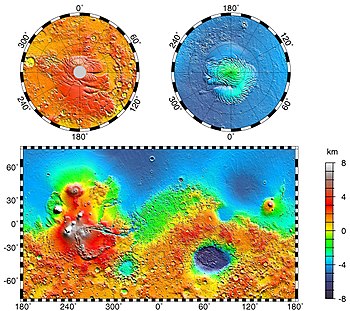
Back فرضية محيط المريخ Arabic Mars ocean theory English Teoría del océano en Marte Spanish Oceanus Borealis French Oceanus Borealis HT Ocean na Marsie Polish Hipótese dos oceanos de Marte Portuguese Mars ocean theory SIMPLE Північний океан (Марс) Ukrainian 火星海洋假说 Chinese


La teoria dell'oceano su Marte suggerisce che, nelle prime fasi della sua storia geologica, quasi un terzo della superficie del pianeta fosse ricoperto da un vasto oceano di acqua liquida.[2][3][4] Questo oceano primordiale, noto come Paleo-Oceano[1] o Oceanus Borealis,[5] si sarebbe esteso nel bacino di Vastitas Borealis, una regione situata nell'emisfero settentrionale a circa 4–5 km sotto il livello medio di elevazione del pianeta, tra 4,1 e 3,8 miliardi di anni fa. Le evidenze a sostegno di questa ipotesi includono formazioni geografiche che somigliano a linee di costa e le proprietà chimiche rilevate nel suolo e nell'atmosfera marziana.[6][7][8] Per permettere la presenza di acqua liquida in superficie, Marte avrebbe dovuto avere un'atmosfera più densa e un clima significativamente più caldo rispetto a quello attuale.[9][10][11][12]
- ^ a b John E. Brandenburg, The Paleo-Ocean of Mars, in MECA Symposium on Mars: Evolution of its Climate and Atmosphere, Lunar and Planetary Institute, 1987, pp. 20-22, Bibcode:1987meca.symp...20B.
- ^ N. Cabrol e E. Grin (a cura di), Lakes on Mars, New York, Elsevier, 2010.
- ^ S. M. Clifford e T. J. Parker, The Evolution of the Martian Hydrosphere: Implications for the Fate of a Primordial Ocean and the Current State of the Northern Plains, in Icarus, vol. 154, n. 1, 2001, pp. 40-79, Bibcode:2001Icar..154...40C, DOI:10.1006/icar.2001.6671.
- ^ J. Alexis P. Rodriguez, Jeffrey S. Kargel, Victor R. Baker e Virginia C. Gulick, Martian outflow channels: How did their source aquifers form, and why did they drain so rapidly?, in Scientific Reports, vol. 5, n. 1, 8 settembre 2015, p. 13404, DOI:10.1038/srep13404, PMC 4562069, PMID 26346067.
- ^ V. R. Baker, R. G. Strom, V. C. Gulick, J. S. Kargel, G. Komatsu e V. S. Kale, Ancient oceans, ice sheets and the hydrological cycle on Mars, in Nature, vol. 352, n. 6336, 1991, pp. 589-594, Bibcode:1991Natur.352..589B, DOI:10.1038/352589a0.
- ^ Mars: The planet that lost an ocean's worth of water, su sciencedaily.com.
- ^ NASA finds evidence of a vast ancient ocean on Mars, su MSN.
- ^ G. Villanueva, M. Mumma, R. Novak, H. Käufl, P. Hartogh, T. Encrenaz, A. Tokunaga, A. Khayat e M. Smith, Strong water isotopic anomalies in the martian atmosphere: Probing current and ancient reservoirs, in Science, vol. 348, n. 6231, 2015, pp. 218-21, Bibcode:2015Sci...348..218V, DOI:10.1126/science.aaa3630, PMID 25745065.
- ^ Peter L. Read e S. R. Lewis, The Martian Climate Revisited: Atmosphere and Environment of a Desert Planet, Chichester, UK, Praxis, 2004.
- ^ A. G. Fairén, A cold and wet Mars Mars, in Icarus, vol. 208, n. 1, 2010, pp. 165-175, Bibcode:2010Icar..208..165F, DOI:10.1016/j.icarus.2010.01.006.
- ^ A. G. Fairén et al., Stability against freezing of aqueous solutions on early Mars, in Nature, vol. 459, n. 7245, 2009, pp. 401-404, Bibcode:2009Natur.459..401F, DOI:10.1038/nature07978, PMID 19458717.
- ^ A. G. Fairén et al., Cold glacial oceans would have inhibited phyllosilicate sedimentation on early Mars, in Nature Geoscience, vol. 4, n. 10, 2011, pp. 667-670, Bibcode:2011NatGe...4..667F, DOI:10.1038/ngeo1243.